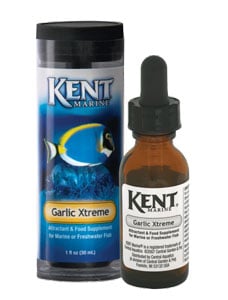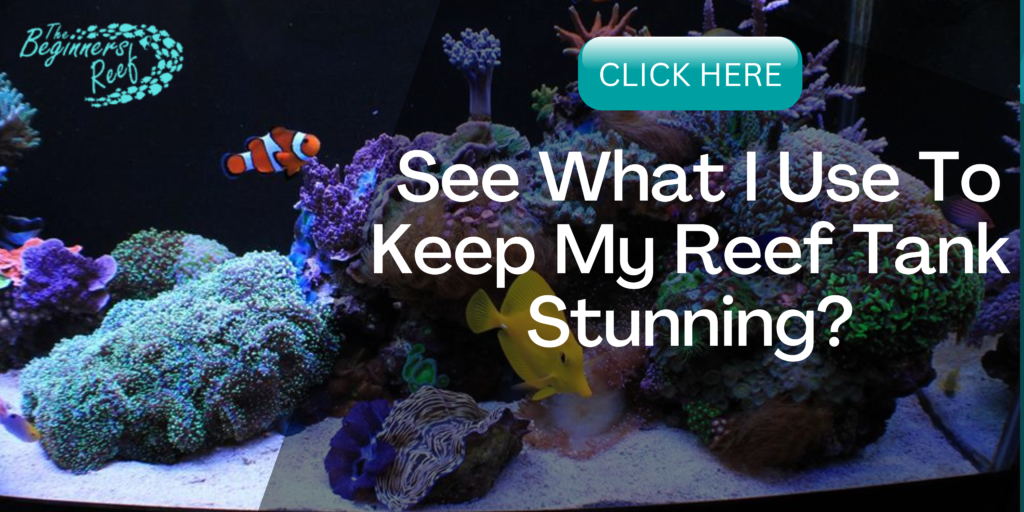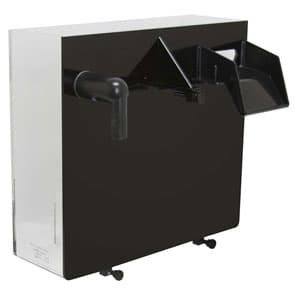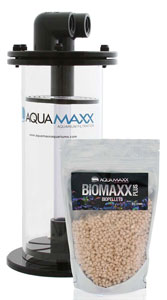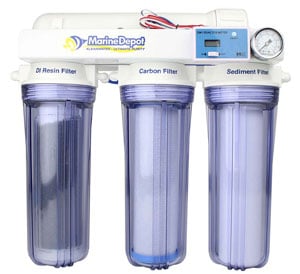At some point in the life of your aquarium journey, you are going to start getting your nitrate level rising to a point when you are becoming concerned. It happens to all of us, especially on our first tank when we have put in too much livestock for what it can handle.
Yes, we all buy too many fish because we want an absolutely stunning reef tank, but we never really paid any attention to the biological filtration side. Now that it has our attention, the question is how do we get the nitrates back to what they should be and keep them there?
Nitrate in a saltwater aquarium can be lowered by regular water changes, reducing the amount of food given, reducing the number of fish, vacuuming sandbed, installing a refugium or turf scrubber, or using liquid nitrate remover. Ideally, nitrate should be kept under 15ppm for a saltwater aquarium.
Nitrates are part of the Nitrogen Cycle. You may have heard about ‘Cycling Your Aquarium’ and nitrate is the last part. In fact, your tank is in a constant state of cycle every time you feed your fish, your fish goes poop or you add a new member.
Our goal is to try and let mother nature balance the Nitrogen Cycle however, for most of us, life can get busy at times, we just can’t resist that bargain at the fish store or we just want to feed that little bit more! This is when we can start to see your nitrate level begin to creep up and step needs to be taken to prevent it from poisoning your livestock.
Ways To Reduce Saltwater Aquarium Nitrate:
- Remove Detritus
- Reduce Food Quantity
- Regular Water Changes
- Rinse Frozen Food
- Reduce Fish Quantity
- Get a Clean-Up-Crew
- Increase Nitrification Bacteria Habitat
- Install a Refugium or Algae Scrubber
- Install a Bio Pellet Reactor
- Install a Nitrate Reactor
- and many more…
High nitrate is ALWAYS because of your actions! If you have one fish in a 200 gallon tank, your nitrate would always be zero! But who wants just one fish!
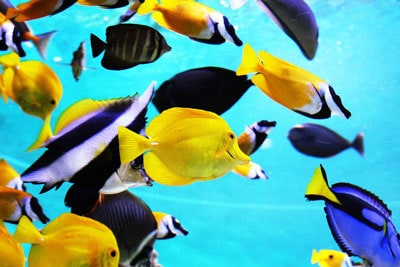
The Main Causes of High Saltwater Aquarium Nitrate are:
- The aquarium is too young for the number livestock within it
- Overstocked. Too many fish
- Not enough Live Rock/Live Sand/Beneficial Bacteria habitat
- Overfeeding
- Little or no water changes
- Small water change volumes
- Too much detritus
- No protein skimmer or protein skimmer is too small
How To Safely Reduce Nitrate in Saltwater Aquariums
Depending on how high you have let your nitrate get will depend on how much work you have ahead of you to reduce them. The main thing to remember with everything in this hobby is to:
MAKE ANY CHANGES GRADUALLY!
Doing a big 50% water change on a 200 gallon tank is just going to cause more trouble. If you have a major pollution incident, that is a different matter, but for nitrate reduction, it is just silly.
The main thing most people are recommended to start by doing is a multi-angle approach to reducing nitrate. What I mean by this is adjusting a few of the easy steps first and see how your nitrate drop.
If nothing is happening after a few more weeks, then we try the next step.
Patience is key here. You need to make a change or some changes, then give your aquarium some time to adjust before you see the result.
The ideal nitrate level you should be aiming for in a saltwater aquarium is:
| Type of Aquarium | Max Nitrate Level |
|---|---|
| Fish Only Tank | < 20ppm |
| Mixed Reef Tank | < 15ppm |
| SPS Dominant Tank | < 5ppm |
Ways To Reduce Aquarium Nitrate:
1. Reduce Feeding Quantity
This is the easiest to fix, and leads to one of the biggest causes of high nitrates because we all love to keep our fish Fat & Happy! However, what we don’t see is all the tiny particles of food that don’t get eaten. They fall into the holes and begin to break down.
Your fish will survive with a smaller quantity of food. You may be surprised that most Reefers will slowly increase the feeding quantity over time without realizing it.
Try feeding half your normal quantity and watch your nitrate drop, and remember to only feed enough that can be consumed in one minute! The more food you feed, the more the fish poop. The more food you feed, the more doesn’t get eaten. These two alone lead to more detritus.
2. Remove Detritus
Detritus and muck left to decay is one of the biggest causes of rising nitrate.
Before each water change get a Turkey Baster and blast all your rockwork, you will be surprised how much crud will come out of all those tiny holes and pockets. Next vacuum the sandbed to help remove detritus trapped within it.
Remove any animal/coral as soon as you see it dying or dead. A rotting corpse will always skyrocket your nitrate.
Ensure you have an open aquascape that allows for good water flow throughout your entire tank. Install more powerheads or more wave makers to ensure no ‘Flow Dead Spots’.
Having a ‘Rock Wall’ and not being able to access behind your rock is an instant way to have high nitrate.
3. Increase Water Change Volume & Frequency
Manually removing the water that is laden with nitrate and replacing it with nitrate-free water will slowly reduce your nitrate level. If you are doing water changes every two weeks try changing to every week.
If you are already doing weekly water changes, try increasing the volume you change. If you are changing 20%, try upping the volume to 25%.
Every little helps! The quality of the water you use also makes a huge impact – More on this later.
4. Rinse Store-Bought Frozen Food
Commercially produced frozen food is full of nitrate-rich ingredients. Always ensure you rinse your frozen food in a mesh sock, or a fish net to rinse as much of the juice away, this will remove a lot of nitrate.
Smell the food too once it has defrosted, if it smells really bad do not use it. The food may have been accidentally thawed, re-frozen, and spoiled in the process.
I create my own frozen food using good quality grocery store-bought seafood with a mix of flakes, pellets, coral food, liquid supplements, nori, and concentrated garlic extract.
It is then blended (which stinks!) then frozen flat in a zip-loc bag. I can then cut off the desired amount, defrost and feed every night. It is much cheaper and contains far fewer Nitrates!
5. Reduce the Bio Load
This is the second biggest cause of high nitrate: Too Many Fish!!!!
We are all guilty of it and it always creates more problems for us. How many times have we been at the store and found that fish at the top of the ‘Want List’ sitting right there in the show tank?
Freshwater seems to give a length of fish per total gallons but that does not work for saltwater. There are too many factors that can make two identical tanks have completely different Nitrate readings. Filtration, bacteria, flow, rock, sand, and Clean-Up-Crew, all play a part.
If your aquarium is just packed with fish then this is most likely the cause of your high nitrate issue. Remove some fish and see if you can swap some fish for store credit at your local fish store.
6. Add a Clean-Up-Crew
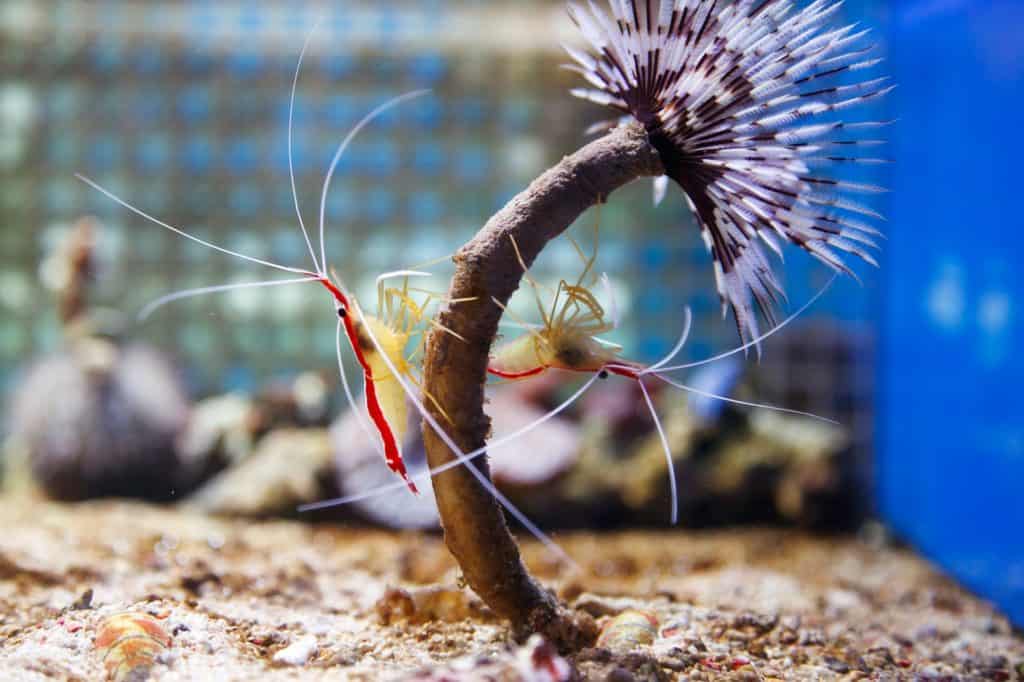
Having an army of tank janitors to tackle every part of your aquarium is essential to help you and mother nature keep your biological load in equilibrium. A good mix of snails, crabs, shrimp & microfauna will help to keep the detritus at bay, especially the detritus that is hiding in the hard-to-reach parts of the aquarium.
Research into the types of crew available and what each critter will do is essential for you to build your army. Having the right amount of each species of animal is also important because if you have too many, the food supply will eventually run out for many of them, at which time they die and add to your Nitrate problem.
Stay away from the store-prepared Clean-Up-Crew Packages as they are all about making money. Do your research, see what’s available locally and purchase your own crew. Also, be sure not to add them all in one go!
For more information on clean-up-crews, please check out his article:
Saltwater Invertebrates – Best For Beginners!
7. Increase Nitrifying Bacteria
When your aquarium initially cycled you were actually growing huge colonies of Nitrobacter and Nitrosomonas bacteria that consume and converts toxic ammonia and nitrite, which then convert it to nitrate which is far less toxic – until it begins to rise over 20ppm.
The final part of the Nitrogen Cycle is the release of nitrogen gas, therefore the more bacteria you can grow, the more ammonia, nitrite, and then nitrate get converted and removed from the tank with water changes and small amounts converted to gas, which releases from the water column.
There are several ways to increase the surface area on which more bacteria can grow:
- Add more Live Rock to your tank or sump
- Add some Live Rock Rubble to your sump
- Add some blocks/balls of MarinePure from Amazon.com – Incredible surface area for their size
- Add a live bacteria culture like Dr. Tims Waste Away available Here at Amazon.com
8. Install a Refugium
Installing a Refugium is a great way to grow Macroalgae and Microfauna without being eaten by your aquariums fish. These both help to reduce nitrate in the following ways:
Macroalgae are a form of saltwater plant. Plants consume nitrate as they grow. You allow the algae to grow in the Refugium and then you dispose of half the ‘Algae Ball’, physically removing the nitrate that is bound within the algae ball.
Microfauna are small and microscopic critters that work on consuming detritus and organic waste within your aquarium. They release tiny parcels of ammonia as they excrete their waste, which is then dealt with by the beneficial bacteria as part of the ongoing Nitrogen Cycle.
They safely grow within your refugium without being eaten.
For more information on Refugiums and Microfauna please check out these articles:
9. Install an Algae Turf Scrubber
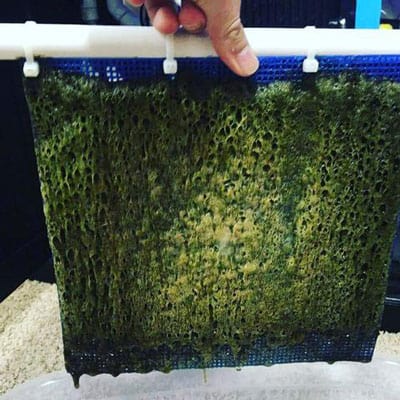
An algea turf scrubber is like a refugium on steroids. They grow algae at a rapid rate in a sealed, light-filled filter out of sight of the main aquarium. As the algae grows it consumes nitrate and phosphate from the water. Each week/month the algea is removed from the scrubber and disposed of, thus removing the bound up nitrate and phosphate form the aquarium system.
For more information on them and suggestions on sizing one to suit your aquarium please read:
Reef Tank Algae Turf Scrubbers – What Are They?
10. Install a Bio Pellet Reactor
Bio Pellets are pellets made from a bio-degradable polymer that provides a carbon-based food source for the beneficial bacteria that consume nitrate. By keeping the Bio Pellets circulating in the reactor they provide a massive surface area for the bacteria to grow and feed on.
As the bacteria feed on and consume the Bio Pellets you just open the reactor lid and add more pellets. Bio Pellets work very, very well at helping to reduce nitrate and are relatively cheap and simple to add to any system.
If you would like to setup a Bio Pellet Reactor please check out this article for more information:
Aquarium Media Reactors – What Are They & How To Use Them
11. Install Nitrate Removal Granuals
Nitrate removal granuals use beads of sulfur to convert nitrate into nitrogen gas, which is then vented.
The sulfur beads encourage the growth of Anaerobic Bacteria which oxidize the nitrate to convert them into nitrogen gas.
The most common way to use this is by adding the granuals to a mesh bag and placing it into the sump or filter compartment of your reef tank.
- Nitrate Removal Granuals Here at Amazon.com
- Mesh Filter Bags Here at Amazon.com
12. Use a Liquid Nitrate Reducer
Solutions like Red Sea’s NO3:PO4-X and Prodibio’s Bio-Digest are liquid solutions you add to your water to give your nitrate feeding bacteria a good meal to help grow and multiply. The more you grow, the more nitrates are converted to gas and the lower your nitrates will be.
These work in a similar way to the granuals but in a liquid form, which can be dosed to the tank by hand or automatically via a dosing pump as and when required.
- Red Sea NO3:POX-4 Here at Amazon.com
- Prodibio Bio-Digest Here at Amazon.com
13. Vodka/Sugar Dosing
Vodka and sugar dosing are also referred to as ‘Carbon Dosing’. Carbon dosing is providing your bacteria with a Carbon-Rich food source for them to grow, multiply and consume nitrate.
These bacteria are then removed via your protein skimmer, which is then emptied by you, thus reducing your nitrate within the system.
Both sugar and vodka are a means to provide the carbon source and there is lots of information with good results online on how to begin carbon dosing.
This carbon is not the same activated carbon you would use to remove dissolved organic material from your water. This form of carbon for the bacteria is the ‘Building Blocks of Life’ type of carbon terminology.
Here is an article from Red Sea Aquatics Chief Scientist on Carbon Dosing
14. Use Only RO/DI Water
This is one of the most beneficial things you can do to ensure a healthy aquarium, especially if you purchase this before initially filling your aquarium for the first time. The amount of junk the city water departments add to your town’s water supply is unbelievable. High nitrate are usually in there!
Investing in a good 4+ stage Reverse Osmosis & De-Ionised (RO/DI) filter system will be one of the best investments for your aquarium. Not only do you need to use RO/DI water for your water changes but also for your Top Off water.
These filters remove the nitrate, and many other pollutants before it goes into your aquarium. This one thing can solve 90% of your algea, and chemical issues!
You can find a great selection of RO/DI water filters specifically for aquariums Here at Amazon.com
To Finish
One of these solutions by itself may not lower your nitrate enough, but combining as many of these fixes as you can will show a marked reduction in your nitrate overall.
Start with the free and cheaper options, and then if you are still testing high levels of nitrate, begin research into one of the more costly options.
I personally run Bio Pellets in a reactor and I have zero nitrates, but I also pay close attention to all the free solutions and all my water is running through a 3 stage RO/DI system like you see above.
Prevention is better than cure!
Further Reading
For more information on learning about and selecting the perfect RO/DI unit for your system, you can read my article:
How To Select An RO/DI System For Your Aquarium.
If you are unsure what ‘Top Off Water’ is please read my article and see how you ever managed without one!:
What Is An Aquarium Auto Top Off?

